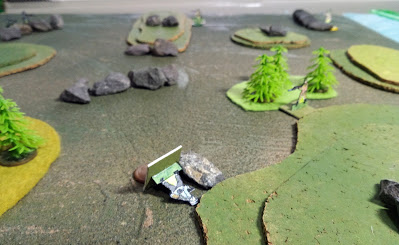I bought and downloaded a bundle of Nordic Weasel stuff a couple of years ago - the original 5 Core game 'Five Men In Normandy', plus a load of supporting material - but hadn't got around to playing it. However I've just finished rereading Antony Beevor's 'Stalingrad' so felt in the mood for some gritty WWII action.
I haven't got any suitable WWII figures (not without disassembling a couple of HOTT armies), so resorted to Junior General instead. You only need a handful of figures, so it was a pretty simple task to assemble a few troops with rifles, SMGs and an LMG for each force.
The rules have a wealth of campaign and scenario generation material. I set up a terrain with plenty of cover, randomly generated a Soviet and German force and gave each of them a mission.
And here they are.
On the left are the Germans. They are on a simple encounter mission; they've just bumped into the enemy and will withdraw once they have inflicted more casualties than they took. There are only four of them - one with an MG34, a rifleman (who acts as his loader), and two men with SMGs.
On the right are the Soviets. They rolled well and got six soldiers, three with rifles and three with SMGs. Their mission was harder though. On the board were five markers in terrain pieces. They had to be searched, with a one in three chance that the one being looked at would contain the thing the troops were looking for. At that point the squad could withdraw.
Everyone started hunkered down behind terrain and out of sight of the enemy.
Anyway, the surprise encounter saw both sides spray some bullets at each other and duck back into their respective covers. But the Soviets now knew where the Germans were.
Firing in 'Five Men In Normandy' involves rolling Shock Dice and Kill Dice. The former are more numerous, and can cause figures to duck into cover or run away. The latter can knock down a figure (which subsequently gets a chance to recover) or take them out of the fight - dead or seriously wounded. Some weapons can choose to trade Kill Dice for extra Shock Dice; the MG34 is one, so can lay down a ton of suppressive fire.
Emboldened he advanced toward the other part of the board where the Russian riflemen were trying to set up a suppressive fire position on the MG34. Once again the displacement rule threw up a surprise; a previously unseen rifleman turned out to be advancing across the same piece of ground, and the two soldiers literally ran into each other (the Soviet was displaced right into a brawl with the German!). There was a brief struggle that ended with the German being killed.
When a side activates you roll a D6. On a 2-5 they can activate two figures. On a 1 or a 6 it's a special turn. A 6 means that nothing can move, but everything can fire. And a 1 means that everything can move and doesn't trigger guard or snap-fire from the enemy. The Soviets got two of these scurry turns in a row, so as the MG34 crew watched helplessly (maybe they were reloading or something), the Russians swiftly moved into better positions.
The wounded German recovered, only to be knocked back down again by a rifle-shot.
The four surviving Soviets withdrew.
The Soviets had completed their objective, but the Germans had inflicted more casualties than they had taken, so the encounter was a draw.
Even having to look stuff up and check rules the action took no more than an hour to play (I rolled the forces and did the setup the day before). It was pretty fun, although there were a few things I wasn't clear about in the rules and about which I will seek clarification.
The mechanisms are fun, and the campaign system is interesting too; maybe something I'll try at some stage, running a player squad against a non-player enemy.
52 Games - Game 28

















I find that is a game that actually works well for roughly one squad per side.
ReplyDeleteThat's certainly what it's designed for. It does suggest how to run it for larger number of figures (you get one activation for every three figures you have), and I think 'Five Men At Kursk' expands the game a fair bit too.
Delete